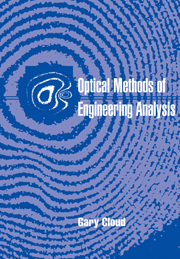Book contents
- Frontmatter
- Contents
- Acknowledgments
- 1 Introduction and orientation
- Part I Optics and interferometry
- Part II Photoelasticity
- 4 Photoelasticity theory
- 5 Basic applied photoelasticity
- 6 Photoelasticity methods and applications
- Part III Geometrical moire
- Part IV Diffraction theory, optical processing, and moire
- Part V Moire interferometry
- Part VI Holographic interferometry
- Part VII Speckle methods
- Author index
- Subject index
4 - Photoelasticity theory
Published online by Cambridge University Press: 12 January 2010
- Frontmatter
- Contents
- Acknowledgments
- 1 Introduction and orientation
- Part I Optics and interferometry
- Part II Photoelasticity
- 4 Photoelasticity theory
- 5 Basic applied photoelasticity
- 6 Photoelasticity methods and applications
- Part III Geometrical moire
- Part IV Diffraction theory, optical processing, and moire
- Part V Moire interferometry
- Part VI Holographic interferometry
- Part VII Speckle methods
- Author index
- Subject index
Summary
One of the oldest and most useful forms of interferometric measurement for engineering purposes is photoelasticity, which involves the observation of fringe patterns for determination of stress-induced birefringence. It is important as a measurement technique. Further, it provides an instructive paradigm of applied interferometry. This chapter presents in some detail the fundamental theory of the photoelastic technique.
Photoelasticity as interferometry
For practical and instructional reasons it is important to recognize photoelasticity as a classic interferometric technique. The path length difference to be measured in the specimen depends on local direction-dependent variations in the refractive index; these variations are usually induced by stress. The surface of the photoelastic model itself acts as the beam splitter because it divides the incident light into orthogonally polarized components. These components travel through the same thickness of material, but the path lengths differ because of the difference of refractive index. Thus, the components exhibit a relative phase difference when they exit the specimen. The phase difference is converted to amplitude information through interference as the two components are recombined at the downstream polarizer, called the analyzer. Because the beam splitting divides a single wave train or a small pencil of waves, photoelasticity is of the amplitude-division class of techniques. It is also a common path interferometer since the two orthogonally polarized waves follow identical geometric paths through the whole instrument. These facts, plus the fact that the path lengths differ by only 20 or so wavelengths, mean that the coherence requirements are not stringent, and ordinary light sources are suitable. Also, vibrations do not have much effect on common path interferometers, so they are easy to use in noisy environments.
- Type
- Chapter
- Information
- Optical Methods of Engineering Analysis , pp. 57 - 76Publisher: Cambridge University PressPrint publication year: 1995

